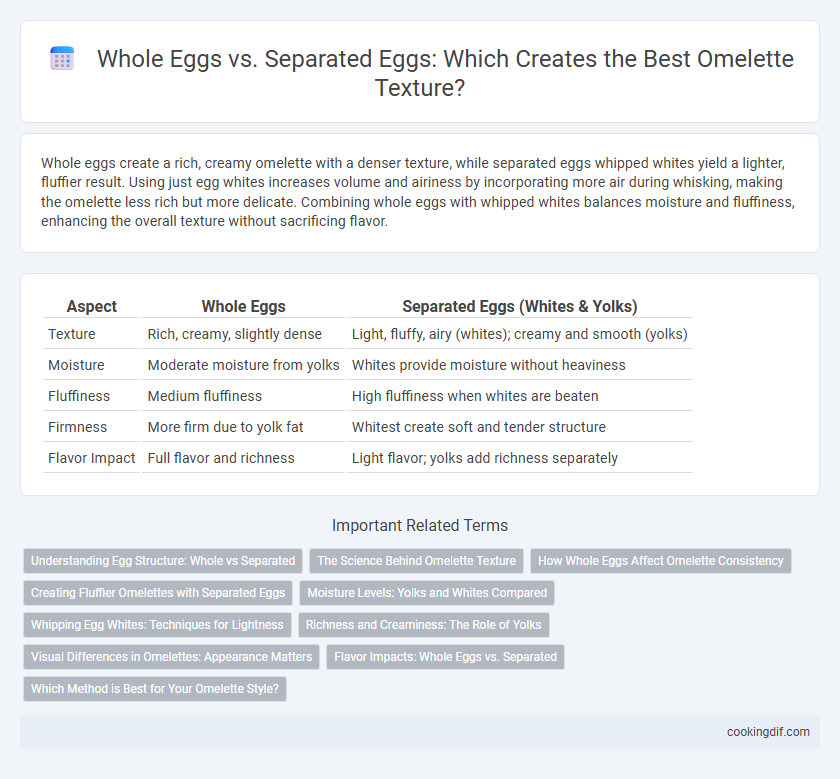Whole eggs create a rich, creamy omelette with a denser texture, while separated eggs whipped whites yield a lighter, fluffier result. Using just egg whites increases volume and airiness by incorporating more air during whisking, making the omelette less rich but more delicate. Combining whole eggs with whipped whites balances moisture and fluffiness, enhancing the overall texture without sacrificing flavor.
Table of Comparison
| Aspect | Whole Eggs | Separated Eggs (Whites & Yolks) |
|---|---|---|
| Texture | Rich, creamy, slightly dense | Light, fluffy, airy (whites); creamy and smooth (yolks) |
| Moisture | Moderate moisture from yolks | Whites provide moisture without heaviness |
| Fluffiness | Medium fluffiness | High fluffiness when whites are beaten |
| Firmness | More firm due to yolk fat | Whitest create soft and tender structure |
| Flavor Impact | Full flavor and richness | Light flavor; yolks add richness separately |
Understanding Egg Structure: Whole vs Separated
Whole eggs create a creamy, cohesive texture in omelettes due to the emulsification of yolks and whites, providing richness and softness. Separated eggs, particularly using only whites, yield a lighter, fluffier texture by incorporating more air during whipping, resulting in a delicate, airy omelette. Understanding the protein structure in egg whites enables precise control over firmness, while yolks contribute to moisture and flavor, influencing the final omelette consistency.
The Science Behind Omelette Texture
Using whole eggs in an omelette creates a denser, creamier texture due to the balanced fat and protein content in the yolk and white, which emulsifies when cooked. Separated eggs, with whipped whites folded into yolks, introduce air and create a lighter, fluffier omelette by trapping protein networks that expand during cooking. The controlled coagulation of egg proteins and the distribution of moisture determine the final texture, making the choice between whole and separated eggs a science-driven decision for achieving desired omelette consistency.
How Whole Eggs Affect Omelette Consistency
Whole eggs contribute to a denser and creamier omelette texture due to the combined protein and fat in both yolks and whites, creating a richer mouthfeel. The yolk's fat content adds moisture and softness, while the whites provide structure and slight firmness, resulting in a balanced, fluffy consistency. Using whole eggs ensures a uniform texture that holds well during cooking and enhances the overall flavor profile of the omelette.
Creating Fluffier Omelettes with Separated Eggs
Separated eggs produce fluffier omelettes because the egg whites can be whipped independently, incorporating more air and creating a lighter texture. Whole eggs, while convenient, result in denser omelettes due to the combined yolk and white which limits aeration. For optimal fluffiness, whipping egg whites to stiff peaks before gently folding in yolks enhances the omelette's volume and softness.
Moisture Levels: Yolks and Whites Compared
Whole eggs provide a balanced moisture level due to the natural blend of yolks and whites, resulting in a tender and slightly creamy omelette texture. Egg yolks contribute fat and emulsifiers that enhance richness and moisture retention, while egg whites add structure and a light, airy quality. Utilizing separated eggs allows precise control over texture by adjusting moisture content, with yolks increasing softness and whites promoting firmness and fluffiness.
Whipping Egg Whites: Techniques for Lightness
Whipping egg whites separately creates a foam rich in air bubbles, enhancing the omelette's lightness and fluffiness by incorporating more volume than whole eggs can achieve. Whole eggs produce a denser texture due to the yolk's fat content, which inhibits maximum aeration during whipping. Mastering techniques such as using clean, dry bowls and gradual sugar addition optimizes the egg whites' stiffness, delivering a superior airy texture in souffle-style omelettes.
Richness and Creaminess: The Role of Yolks
Using whole eggs in an omelette maximizes richness and creaminess due to the inclusion of yolks, which provide essential fats and emulsifiers that contribute to a velvety texture. Separated eggs, particularly using only egg whites, result in a lighter, fluffier omelette but lack the depth of flavor and smooth mouthfeel that yolks impart. Yolks enhance the omelette's moisture retention and create a denser, silkier consistency that whole eggs uniquely deliver.
Visual Differences in Omelettes: Appearance Matters
Whole eggs create a uniformly yellow omelette with a dense, creamy texture, while separated eggs produce a lighter, fluffier omelette with distinct layers of whites and yolks. Visually, whole egg omelettes appear smooth and consistent, whereas those made from separated eggs showcase a more porous and airy structure. Chefs often choose whole eggs for a rich appearance and separated eggs to achieve a delicate, cloud-like presentation.
Flavor Impacts: Whole Eggs vs. Separated
Whole eggs create a richer and creamier texture in omelettes due to the combined fat and protein content, enhancing overall mouthfeel and flavor depth. Separated eggs, particularly using only egg whites, produce a lighter, fluffier texture but result in a milder taste as the yolk's fats and flavor compounds are absent. The balance between whole and separated eggs allows for customization of omelette texture and flavor intensity based on culinary preferences.
Which Method is Best for Your Omelette Style?
Using whole eggs in an omelette yields a denser, richer texture ideal for hearty, traditional styles, while separated eggs--where whites are whipped and folded in--create a lighter, fluffier consistency favored in souffle or French omelettes. The choice depends on desired texture: whole eggs provide a uniform creaminess, and separated eggs enhance airiness and volume. For a classic, robust omelette, whole eggs are best, whereas separated eggs suit delicate, airy preparations.
Whole eggs vs Separated eggs for texture Infographic

 cookingdif.com
cookingdif.com